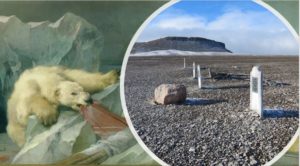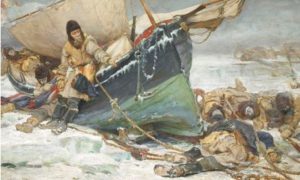Toronto Star searching for Franklin


Images: Edwin Landseer & Sheena Fraser McGoogan
From the Toronto Star, August 19, 2023
By Ken McGoogan
The Franklin search season is almost upon us. Last year, during eleven days in early September, Parks Canada underwater archaeologists retrieved 275 artifacts from HMS Erebus. That ship was one of the two recently located wrecks from the 129-man expedition that, led by Sir John Franklin, disappeared into the Arctic in 1845. This year, as soon as weather permits, Parks Canada will resume its investigations.
Meanwhile, late in July, National Geographic magazine published a massive article online, complete with photos and videos, headlined: “Seeking to solve the Arctic’s biggest mystery, they ended up trapped in ice at the top of the world.” It features Tom Gross, who has been scouring King William Island for a burial vault that he believes holds Franklin’s body — and possibly logbooks or documents. With Jacob Keanik, an Inuk who lives on the island, Gross will resume his search any day now.
Books about Franklin and his doomed expedition, which already number in the hundreds, continue to appear at a rapid rate. (See below for where to begin.)
Outstanding documentaries have treated the expedition, among them Franklin’s Lost Ships (Andrew Gregg, 2016) and Passage (John Walker, 2008). A furiously active Facebook group, Remembering the Franklin Expedition, boasts more than 3,400 members.

But why does this expedition, which disappeared into the Arctic almost 180 years ago, continue to attract attention. First, the catastrophe cost the lives of 129 men, making it the worst in exploration history.
Second, some final survivors resorted to cannibalism, which prompted international headlines. Third, the formidable Jane Lady Franklin made a mythical hero of her late husband as “discoverer of the Northwest Passage.”
Fourth and above all, here we have, as National Geographic put it, the “Arctic’s biggest mystery.” The expedition was expected to solve the riddle of the Northwest Passage. What happened?
Researchers have been seeking answers since 1848. A written document found in 1859 – the Victory Point Record — filled in a few blanks. The expedition crossed Davis Strait, entered Lancaster Sound, probed Wellington Channel northwards, and then spent the winter of 1845–46 on Beechey Island. Here, Franklin buried three crewmen.
In 1846, when the ice melted, the two ships sailed south into Peel Sound. On September 12, they got trapped in the ice off the northwest coast of King William Island. Nine months later, on June 11, 1847, Sir John Franklin died.
Then, on April 22, 1848, 105 men departed from the two ships, which were still beset in the ice. By that time, nine officers and fifteen seamen had died. Given three men buried on Beechey, twenty-one died between spring 1846 and April 1848.
A previous Royal Navy expedition had spent four winters trapped in the Arctic (1829-1834). Almost all men had escaped back to England. Why, with Franklin, did so many die so early? The Inuit reported seeing disoriented men trekking along the coast of King William Island and dying in hospital tents. What?
In 1984, on Beechey Island, forensic anthropologist Owen Beattie exhumed the remains of the first three sailors to die. In Frozen in Time, with co-author John Geiger, he suggested that lead poisoning, contracted from the solder used to seal cans of preserved food, killed some men and sickened the rest.
This view prevailed for two decades. But then some scientists doubted that tin cans could produce enough lead to be lethal. Others suggested that maybe the lead came from the ship’s pipes. Researchers then determined that, for sailors of that time, the lead levels of the three dead on Beechey were not unusual.
In April 2014, three British scientists—Keith Millar, Adrian Bowman, and William Battersby—published a statistical analysis in Significance magazine, arguing that a combination of factors killed the sailors. In his introduction to May We Be Spared to Meet on Earth, a collection of letters, American expert Russell Potter summarized, noting that “lead poisoning can no longer be seen as the sole or primary cause of the expedition’s downfall, though it certainly may have been one factor.”
A few writers had pointed to botulism as an alternative root cause. But as Potter observes, this “seems highly unlikely” as the poorly sealed tin cans admitted oxygen, which along with salt and nitrates would have constrained botulism. Early letters sent home from Greenland find the sailors raving about the soups and, years later, Inuit who opened some tin cans enjoyed their contents very much.
Bottom line: leading researchers have ruled out lead poisoning and botulism as the root cause of the catastrophe. Fact remains: 37 per cent of the officers had died by 1848, but just 14 per cent of the regular seamen. Why such disproportion?
What galvanized 105 men to leave the ships (though some of
them, clearly, later reboarded)? Why were so many so sick that they could not walk straight? Why did some appear to be sheltering (and dying) onshore in a hospital tent? Questions like these keep many of us searching for answers – whether underwater, on land, or at our desks.
(This fall, with Douglas & McIntyre, Ken McGoogan will publish Searching for Franklin: New Answers to the Great Arctic Mystery.)

Don’t know where to begin your quest? These five books point the way:
Frozen in Time: The Fate of the Franklin Expedition, by Owen Beattie and John Geiger. Greystone, 1987. Advances the lead poisoning theory after three bodies exhumed.
Unravelling the Franklin Mystery: Inuit Testimony, by David E. Woodman. McGill-Queen’s, 1991. Extensive analysis of Inuit oral testimony, often graphic.
Ice Blink: The Tragic Fate of Sir John Franklin’s Lost Polar Expedition, by Scott Cookman. John Wiley, 2000. Rejects lead poisoning, points to botulism.
May We Be Spared to Meet on Earth: Letters of the Lost Franklin Arctic Expedition, ed. Russell Potter and others. McGill-Queen’s, 2022. Brings sailors to life in their own words, rejects lead poisoning and botulism.
Dead Reckoning: The Untold Story of the Northwest Passage, by Ken McGoogan. HarperCollins Canada, 2017. Highlights the role of the Indigenous peoples in Arctic exploration.